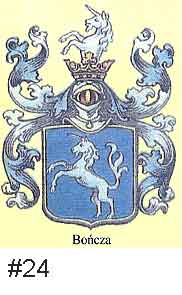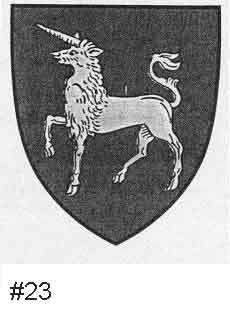


7. Guliński family of Bończa clan
Gulińskis of Bończa home are listed by Boniecki (1), Leszczyc (2), and Bobrowicz (3). Leszczyc thinks, that Gulińskis come from Golińskis, and Gólińskis, but no documents show Gólińskis. Golińskis instead, are originated from Golina, in Konin County. Due to these facts, Leszczyc theory should be disregarded. Leszczyc lists Gulińskis in 1500 from Wielkopolska, Sandomierz province, and also in 1630 from Mazovia, but doesn't reveal his sources.
According to Leszczyc, one of Guliński branch lost the noble status, but during parliament session at 17. III.1595 in Cracow, with King's Zygmunt III presents, the nobility status was restored. The restoration happened by admittance of meritorious Kasper Guliński, Lvov Casher, and his wife Dorota to nobility, and Bończa clan by Jan Dymitr Solikowski, Lvov Arcybishop (4,3). Kasper of Bończa home most likely is a son of Stanisław Guliński, described in previous chapter.

It is unknown, when and why Kasper, who was born around 1560 come to Lvov. He is mentioned in King's Zygmunt III order to settle disaggreement by Lvov starost office, between Jan Niepszycki, and a Lvov townsman Kasper Guliński. (5) Some light on the life of Kasper brings unfavourable note from Alembek, Lvov councillor. After Alembek lost a court case against other city councillors, feeling unjustified, in his diary wrote how the Providence revenged on his enemies. This way we know, that Kasper was one of them. Alembek writes: "Kasper Guliński was znaczny kupcem, he let his daughter to marry a noble, later he let his son to marry one of noble origin. In this process Kasper deminished his wealth. A period of time he lived in Dominican monastery, to hide from his creditors, then he get a stroke. Kasper's son was taken by Tatars as a prisoner, and second younger one, become a monk." (6)

Let's look into the documents. Wojciech, born around 1580, son of Kasper and Dorota, married Anna of Zalesie. Their children were son Jan (3,7), and daughters: Regina, Dorota, Anna and Katarzyna (8). Jan Guliński in 1615 owned part of Ostrowie and Mędowo (9). Wojciech, probably Jan's son, during Tatar assalt on Lvov in 1695, died as prisoner of war. There is no published documents with information about Kasper's daughter, nor his younger son.
Krzysztof, who participated in Turkish wars, was another son of Jan Guliński. His son was Antoni, who then had son Wojciech. Wojciech had son Franciszek, and Franciszek had a son Sebastian Guliński, who married Agnieszka Komorowska (29). They had two sons: Stanisław, Forest Administrator, and Marceli. Both proofed a noble status in Polish Kingdom in 1848 (7,11), and Bończa clan roots.
Other member of Gulińskis of Bończa clan was Aniela, in 1755 a widow, after Kazimierz Szymanowski (12).
The genealogical tree of Guliński family of Lvov branches presented here.
Paszkiewicz (13) assigns Gulińskis to the Junosza clan, but he also doesn't reveal his sources.
Typical nobility residences are presented on the following photos: E , F , G and H.
8. Other Gulińskis
The enigmatic individual is Jan Guliński (14,15) whose signature was "a Gulin". Probably he came from the Radomian Gulinski tree. It is not known where he was educated, but he proved his knowledge of the classical and church literature brought probably from unknown Lutheran University. In 1633 as "a young" theologian Lutheran, he become a teacher of the Polish language in Gimnazjum Akademickie in Gdańsk (16), where he developed his pedagogical and literary activities. He taught publicly and privately Polish pronunciation, spelling, epistolography and Polish history. In St. Ann chapel of St. Trinity church, replacing Jan Dorsz, Jan delivered sermons in Polish. Jan was an author of sermons, poetry, translations, and other works (17,18). His play was performed at the Gdańsk City Hall. He dedicated many of his works to the City government, but could not improve his financial and social status. Discouraged, or for new opportunity in 1644 Jan left Gdańsk. According to Gross (18) who references A. Jocher (19), Jan died in 1644, but Joher doesn't mention that fact.
Andrzej Guliński was an archivist. He began his work in 1838 as a tutor of Polish Archives in Warsaw. He worked on the inventory of the Royal Archives documents. The result of his passion and scientific aspirations is his work "History of Polish/Lithuanian Royal Certificates", which he finished in 1853. This work was completed, but never published. The script, at last, landed in 1902 in Archiwum Akt Dawnych (Old Documents Archives) in Cracow. The work is valuable because of the content and the first historical look at the subject. Guliński was an extensive reader, possessed correct intuition in archival methods, a lot of knowledge of conservation issues and a great adoration for the monuments of the past. He worked also on other documents, and got promoted to the second highest position in the Archives. To his title of Archivist, on his script of "History of Polish/Lithuanian Certificates", someone added "royal", which reflects the right status, which Guliński justly admitted to himself. He died 10.X.1870 (18,20).
Antoni Guliński b.1824, an administrator of 1571 morg (21) Łaski property Januszewice-Kliny-Świerczyn, near Opoczno, married Katarzyna Karpińska. In 1855 their son, Hipolit Guliński was born (22). He married Józefa Robakowska b. 19.III.1863. In 1892 Hipolit, was an Opoczno commune counselor, and he lived in Opoczno. From this marriage came Aleksander b. 8.VIII.1889, and Marian, b.10.XII.1892 in Bukowiec near Opoczno. After Marian married Lucyna Szmitt, the family moved to Koło, where 28.VIII.1918 Józef, my father was born, and then to Poznań, where my father' brother, Kazimierz was born. In Poznań, Marian owned a grocery store. After completion of higher education, both Marian children got married in Poznań.
Another interesting individual was Stanisław Guliński. Born 18.III.1894 in Warsaw, he was the son of Józef and Jadwiga Lewicka. He finished a business school in Leipzig, and then he studied business at the Warsaw Business University. From 1914 he fought in Polish Legions. He was arrested for political activities, and in 1917 he was placed to P.O.W.. Until the end of occupancy he was a commanding officer of Kalisz and Piotrków Trybunalski region. From 1927 he was a city and county Starost of Radom. He published a "Józef Piłsudski" booklet, and many social and political articles (23).
Other known soldier who was fighting during WWII, was Józef Guliński (Ken), a commander of A.L. squad, active in the Ostrowiec area (February 1944) (24).
9. Quick summary
Because of complicated genealogical tree, it is impossible to classify the whole Guliński family. Starting from Jan of Bidziny, for many generations Gulińskis were knights. Later like many others, they settled down on their properties, and returned to army duty as a part of "pospolite ruszenie".
It appears that the Radomian tree was wealthiest between XIV and XVII century. In XVII century Radom region was destroyed by Swedish Wars, Cossacks and Mongols, and probably because of the war destruction, Gulin was sold to Brzezińskis.
Guliński and Kaszowski families took the active part in the Polish Reformation. The Bończa clan branch returned to Radom region.
Trough the years Gulińskis properties were partitioned, and become smaller and smaller. There are no sources about Gulińskis from XVIII century. Most likely like many others they steadily sold properties, and become civil servants, or administrators. But not all of them. Some others in XIX century still owned land properties, like Józef in Gnojno.
Andrzej Guliński